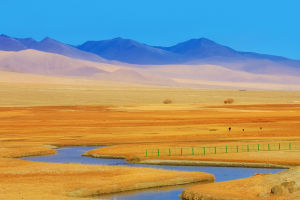Limestone peaks are some of the most stunning geological formations in the world.
They are formed from the accumulation of sedimentary rocks, primarily limestone, which have been compressed and eroded over millions of years.
These peaks can be found in many parts of the world, from China's Zhangjiajie National Forest Park to the limestone cliffs of the Caribbean islands. In this article, we will explore the beauty and majesty of limestone peaks and delve into the geological processes that create them.
Limestone peaks are formed from the accumulation of sedimentary rocks, primarily limestone, which are composed of calcium carbonate. This material is deposited on the ocean floor by the shells and skeletons of marine organisms, such as corals, clams, and other invertebrates. Over time, the sediments become compacted and hardened into rock, forming vast limestone deposits.
As these deposits are exposed to the elements, they undergo a process of erosion. Rain, wind, and other natural forces slowly wear away at the rock, carving out deep valleys and steep cliffs. Over millions of years, these erosive forces create the distinctive shapes and patterns that we see in limestone peaks today.
Limestone peaks are known for their striking beauty, with their dramatic shapes and intricate patterns. The natural erosion of the rock creates a range of shapes and sizes, from towering spires and steep cliffs to rugged canyons and deep valleys.
One of the most famous examples of limestone peaks is the Zhangjiajie National Forest Park in China. This park is home to a collection of towering pillars and spires, some of which rise more than 600 meters above the ground. The peaks are often shrouded in mist, giving them a surreal and otherworldly appearance.
In addition to their dramatic shapes, limestone peaks are also known for their intricate patterns. The erosion of the rock creates a range of textures and patterns, from smooth surfaces to jagged edges and deep fissures. These patterns are often highlighted by the interplay of light and shadow, creating a stunning visual effect.
Limestone peaks are not only beautiful, but they also have significant geological importance. Limestone is an important rock type, as it contains a wealth of information about the Earth's history. The fossils and other organic materials preserved in the rock provide valuable insights into the evolution of life on our planet.
In addition, limestone deposits are important sources of mineral resources, such as lime, which is used in a variety of industrial applications, including the production of cement and steel.
Despite their natural beauty and geological significance, limestone peaks are also under threat from human activities. Deforestation, mining, and other forms of development can all damage or destroy these fragile formations.
To preserve these natural wonders, it is important to take steps to protect them. This can include measures such as limiting development in sensitive areas, creating protected areas and national parks, and promoting sustainable tourism practices.
In addition, education and awareness are key to ensuring that people understand the value and importance of these geological wonders. By sharing information about the geological processes that create limestone peaks, as well as their cultural and natural significance, we can inspire people to appreciate and protect these incredible formations for generations to come.
Limestone peaks are some of the most stunning and remarkable geological formations in the world. Their unique shapes and patterns, created by millions of years of natural erosion, are a testament to the beauty and power of nature. While they face threats from human activities, these natural wonders can be preserved for future generations through responsible development, protection, and education. By appreciating and protecting limestone peaks, we can ensure that they continue to inspire and awe us for years to come.


